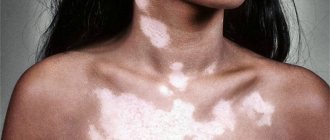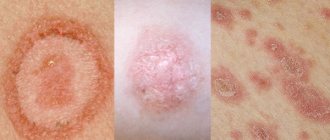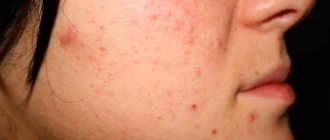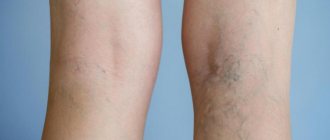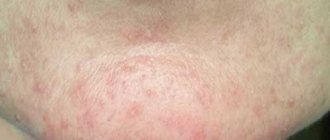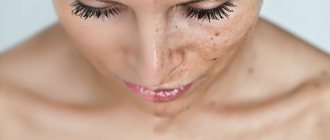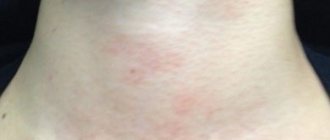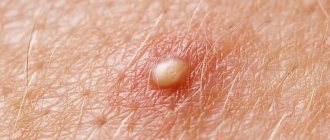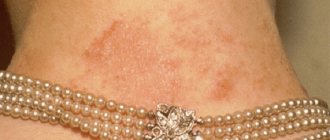Pink spots on the skin are an extremely common problem. Pinkish, red, pale pink or pink-brown, they can be symptoms of a wide variety of diseases, and not just dermatological ones. In any case, the appearance of spots on the skin is a signal about the presence of problems in the functioning of any systems of our body. It should be especially alarming if the spots itch, flake, cause severe discomfort to the person and rapidly increase in size.
Causes of redness and peeling of the skin on the face
The skin of the face flakes and turns red under the influence of both external and internal factors.
The most common of them:
| External factors | Internal factors |
| Improper skin care (washing with hot water, using drying products, abuse of peelings). | Side effects from medications. |
| Incorrectly selected and low-quality cosmetics. | Hormonal imbalance, menopause in women. |
| Weather influences (frost, strong wind, sun - under their influence the skin can become chapped, get burned or frostbite). | Allergy. |
| Ecologically unfavorable places. | Avitaminosis. |
| Mechanical and hardware facial cleansing. | Smoking, alcoholism. |
| Diseases of internal organs. |
Redness and flaking of the skin on the face may also occur upon contact with:
| Plants | Insects |
| Hogweed (depending on the type of plant, its sap can cause a chemical burn or increase the effect of ultraviolet rays, which leads to sunburn). | Spiders. |
| Burning bush (its volatile essential oils cause irritation and burns, so in hot weather it is dangerous to be near this plant). | Butterflies, fluffy caterpillars. |
| Ruta | Wasps, bees, hornets. |
| Nettle | Scolopendra. |
| Celandine | Cockroaches. |
Systemic lupus erythematosus
An autoimmune disease characterized by the destruction of cells in all organs. Genetic pathology. Its occurrence can be triggered by hormonal imbalances, allergies, and prolonged exposure to the sun. First, redness appears on the face in the form of a butterfly. It affects the nose and cheeks. Patients report weakness, loss of appetite and fever. Then there is pain in the muscles and joints. Massive cell death leads to disruptions in the functioning of all organs and systems. Treatment consists of taking immunosuppressants, anti-inflammatory and hormonal drugs.
Diseases that cause similar symptoms
The skin of the face peels and turns red in a number of dermatological diseases:
- Seborrhea is a dysfunction of the sebaceous glands, most often manifested in the area of the nasolabial triangle, forehead and near the eyebrows.
- With excessive activity of the sebaceous glands of “oily seborrhea,” the disease is accompanied by profuse sweating, enlarged facial pores, and redness of the skin, which is provoked by inflammatory processes in the epithelium. Acne often occurs.
- When the sebaceous glands are inhibited, “dry seborrhea” is formed. It is accompanied by feelings of tightness and dryness of the skin. Small flaky areas of the epithelium appear, which acquire a pinkish or red color. There is a burning sensation and itching.
Dermatitis is an inflammatory process of the epithelium provoked by internal and external factors.
Common forms of dermatitis:
- allergic;
- contact;
- atopic.
Dermatitis is one of the reasons why facial skin turns red and peels.
The contact form of dermatitis occurs abruptly from exposure to an external irritant. It manifests itself as redness, burning, itching. In some cases, a rash, swelling, and ulcers appear on the skin. The symptoms of allergic and contact dermatitis are similar. However, allergic dermatitis may appear some time after encountering an irritant or upon subsequent encounter with an allergen.
Atopic dermatitis is a chronic disease that is inherited. If there is a predisposition to the disease, it begins to develop in children aged 1-5 years and manifests itself in cases of malnutrition, neuropsychiatric disorders, diseases of the gastrointestinal tract, in the form of redness, rash, and swelling.
There are 3 stages of the disease:
- Acute stage. It occurs during direct contact with an irritant. The disease manifests itself as redness, rash, swelling, and sometimes the skin begins to itch. When the stimulus disappears, all symptoms disappear.
- Subacute stage. At this stage of dermatitis, first scales and then a crust form on the skin.
- Chronic stage. It occurs if there is periodic contact with an irritant for a long period of time.
Psoriasis begins with itching and a rash of red spots, which transform into papules with a diameter of 1-3 mm. Over time, the formations merge into light gray or silver plaques that begin to peel off.
Beneath the easily removable scales is shiny red skin. If plaques are scratched, they may increase in size. Gradually, the itching and rashes decrease, and light pink spots remain in place of the papules.
Erythema - is infectious or non-infectious in nature. Erythematous rashes are provoked by the expansion of capillary vessels in the skin. The spots may merge with each other. They do not have a specific shape. Color from pink to burgundy with blue. The disease most often occurs at the age of 20-30 years.
Systemic lupus erythematosus is a chronic, systematic disease. It mainly affects women. It affects the skin, connective tissues, and large joints. The disease is characterized by the manifestation of erythematous dermatitis on the face.
A butterfly-shaped redness forms on both cheeks, extending across the bridge of the nose and the bridge of the nose. Subsequently, the skin becomes sensitive to sunlight and peeling in the affected areas. The scales are painfully separated from the skin.
Zhiber's pityriasis rosea is an infectious-allergic etiology of the disease. It occurs as a result of decreased immunity after suffering from colds, allergic diseases, and severe stress. Ringworm begins with maternal plaques, single, round, pink rashes up to 2-4 cm in diameter.
Subsequently, the center of the plaque turns yellow and begins to peel off. The edges of the formation have a pink edging without scales. After a few days, a characteristic rash with a smaller diameter of 0.5-1 cm spreads throughout the body.
According to doctors, pityriasis rosea is not contagious, but contact with the patient should be limited. It is recommended to observe the rules of personal hygiene and not to share the same towel, washcloth, or bed linen with the patient. In most cases, the spots appear within 1-2 weeks and then go away on their own.
Fungal infections are different types of pathogenic fungal microorganisms, these include:
| Disease | Signs |
| Pityriasis versicolor or versicolor. | It appears as asymmetrically shaped spots on the top layer of the skin. Initially, the spots are yellowish, brown or pink. As they grow, they can merge into one large spot. Over time, the plaques become light brown in color. The skin affected by the fungus peels off. In rare cases, it begins to itch. |
| Microsporia, trichophytosis or ringworm | Spots with clear contours. A pink ridge with serous blisters forms along the contour of the affected area, which subsequently turns into a crust. The spot itself is covered with gray scales. |
| Candidiasis | At the beginning of the disease, redness appears, which is then covered with small blisters and pimples. When the bubbles burst, erosion forms in their place. |
Symptomatic manifestations
Symptomatic manifestations may prompt thoughts about progressive autoimmune diseases. It is impossible to determine an accurate diagnosis on your own; even doctors cannot always do this. It’s not a matter of professionalism, it’s just that some symptoms fit a number of diseases.
The most common autoimmune diseases and their symptoms:
Rheumatoid arthritis . The affected area is small joints.
Signs:
- general weakness;
- elevated temperature;
- swelling;
- short-term numbness of the limbs;
- joint pain.
Multiple sclerosis . The affected area is the nervous system.
Signs:
- loss of sensation;
- decreased visual acuity;
- unusual tactile sensations appear.
Diabetes mellitus type 1. The affected area is the entire body. A person, once diagnosed with diabetes, becomes dependent on insulin injections for the rest of his life.
Signs:
- constant feeling of hunger;
- strong thirst;
- excessive urination.
Vasculitis . One of the most dangerous autoimmune diseases. The affected area is the circulatory system. Consequences - capillaries lose their strength, internal bleeding appears.
Lupus erythematosus . The affected area is the entire body. The whole body is covered with red spots that peel, itch, and hurt.
Signs:
- rapid heartbeat or pain in the heart area;
- hard breath;
- chronic fatigue.
Red spots are peeling
If the red spots on the face are flaky, this may be a sign of an affected organism. Most likely, we are talking about serious illnesses. Immediate examination by a doctor is necessary.
In addition to spots, you need to pay attention to the symptoms:
- increased body temperature;
- severe joint pain;
- enlarged lymph nodes;
- high blood pressure;
- heartache.
Emergency measures to relieve redness and flaking of the skin
The skin of the face peels and turns red due to internal pathologies and fungal infections. The possibility of serious illness should be ruled out before attempting to eliminate visual skin imperfections. It is recommended to use medications according to a prescription, only after examination by a doctor.
If redness and peeling are caused by an allergic reaction or an insect bite, you should take antihistamines as quickly as possible, such as:
- Suprastin.
- Lomilan.
- Zyrtec.
- Xizal.
Lubricate the area of redness, bite or peeling on the skin with anti-allergic and anti-inflammatory ointment:
- Fenistil. Relieves itching and eliminates inflammation. All forms of medication are suitable for children.
- Menovazin. The medicine has analgesic and anti-inflammatory properties.
- Bepanten. The drug is available in the form of ointment and cream; it promotes skin healing and relieves inflammation. The medicine is recommended by pediatricians for children from infancy.
- Hydrocortisone. The drug relieves swelling, burning and itching. It contains an analogue of endogenous hormones. It is ineffective against bee stings, but it eliminates peeling well.
If your facial skin is sunburned, it is recommended:
- Take a cool shower or wash your face without using soap or scrub, as they further dry out the skin and damage it.
- To restore water balance, drink warm water.
- In case of severe pain and fever, it is necessary to take an anesthetic or antipyretic medication (Ketanol, Nurofen).
- Treat the affected areas of the skin with Panthenol, Bepanten, Dexpanthenol spray or ointment. If there is no medicine, apply a thick layer of sour cream, yogurt, or vitamin E to the reddened area.
Prohibited:
- Lubricate the skin with alcohol-based lotions.
- Wipe with ice.
- Puncture blisters that have formed on the affected skin.
In case of chapping of the face:
- The water for washing should be warm.
- Wash products should not contain aggressive substances (antibacterial soap, peelings).
- Treat the facial skin with ointments containing dexpanthenol. Masks based on olive oil or almond oil, sea buckthorn are possible.
Recommended actions for frostbite on the face:
- Move to a warm place.
- Rub the skin with your fingertips to restore blood circulation.
- Drink a warm drink with honey, chamomile, linden blossom.
- When the skin gradually warms up on its own, carefully apply Bepanten ointment.
Forbidden:
- Wash with hot water.
- Apply heating pads to frostbitten areas.
- Located in a hot room.
- Drink drinks containing alcohol.
These actions can provoke skin necrosis. Only stage 1 frostbite can be treated independently.
Reasons for appearance
There are many reasons for the appearance of red spots on a person’s face, especially in people under the age of 30; later, such a dermatological problem occurs much less frequently.
Moreover, this phenomenon can be observed in young children, as well as in boys and girls during adolescence.
Unfortunately, the appearance of red spots on the face is a very common dermatological defect, which can be caused by a number of reasons:
- First of all , we can note the very peculiarity of the skin. Very often, spots appear on dry and sensitive skin.
- Red spots may appear from too frequent and strong rush of blood to the face. This can be caused by:
- Intense physical activity.
- Due to nervous breakdowns and stress.
- If you suffer from high blood pressure.
- If you are taking any medications, be sure to consult your doctor to see if they cause an allergic reaction in you. An allergic reaction can be triggered by:
- Environmental conditions.
- Sudden changes in temperature.
- Direct exposure to sunlight.
- Also , red spots may appear after frostbite of the skin, exposure to frost on the skin of the face and general frostbite of the entire body.
It is recommended that before going outside, lubricate your face with a moisturizing (or protecting from the effects of cold) cream, in addition, apply a thin layer of powder or foundation.
Also, you should take into account this number of reasons that can cause an allergic reaction:
- Incorrectly selected cosmetic products.
- Taking any hormonal medications.
- Allergy to any food product or dye.
- Fungal infection of the skin.
- Improper functioning of the intestines , stomach or gallbladder.
- Impaired metabolism as a result of poor nutrition, adolescence in adolescents or pregnant women.
- Frequent stress and stressful situations, violation of psychological and emotional health and condition of a person, frequent hormonal disruptions.
- If red spots were found in men, this could be caused by cosmetic products that do not match the structure of the facial skin, such as shaving foam, lotions, etc. Incorrect selection can cause dryness, inflammation and red, sore spots, as well as pain. If you cannot find the right cosmetic set on your own, you need to contact a specialist who will determine your skin type and prescribe the right care and suitable products.
- Red spots in children , which are localized in the mouth, nasal cavity or chin, most often indicate a disordered and unhealthy diet, or an allergic reaction to any product. Also, this may indicate a disease such as oral dermatitis.
- Red spots can appear as a result of viral diseases such as herpes, chickenpox or lichen (a bacterial infection). This also includes skin diseases such as acne, psoriasis, rosacea, and pityriasis rosea.
- Also, allergies can be triggered by plant pollen or an allergy to animal fur. Any of these factors may cause itching, flaking, swelling, or sneezing.
- In addition to everything , you should also make sure that your diet contains the normal amount of vitamins and nutrients.
Otherwise, a person may notice the appearance of red, scaly spots on the face. If you detect at least one of the above suspicions of an allergic reaction, it is immediately recommended to consult a specialist for advice.
Treatment options
After determining the cause of redness or peeling on the skin, the doctor determines treatment. To achieve optimal results, treatment methods and medications are combined.
Drug treatment
When treating facial skin diseases, your doctor may prescribe:
- Antibiotics for the treatment of pathologies caused by pathogenic microorganisms, fungi, parasites.
- Antimycotics for fungal skin infections.
- Antiallergic drugs to relieve swelling, itching, irritation.
- Glucosteroids to reduce hyperemia, as an anti-inflammatory, immunoregulatory, antiallergic agent.
| Disease | Treatment |
| Seborrhea, dermatitis | Antibiotics: Unidox solutab, Tetracycline, Doxycycline Antifungal drugs: Nizoral, Mycospor, Lamisil Antiallergic drug: Supradin, Lomilan, Zyrtec |
| Fungal diseases: Candidiasis, keratomycosis | Antimycotic drugs: Fluconazole, Nizoral Immunomodulators: Lykopid, Lymphomyosot Antifungal ointments: Mycozoral Antihistamines: Erius |
| Psoriasis | Anti-inflammatory ointments: Diprosalik, Salicylic ointment Anti-allergenic and anti-toxic drug: Sodium thiosulfate |
Medicines can be combined with physiotherapeutic procedures. Photochemotherapy is the most widely used. With this treatment, taking medications of a certain group is combined with UV radiation.
Cosmetology creams and masks
For dry and irritated skin, creams that do not contain preservatives are recommended. They must have a hypoallergenic and anti-inflammatory effect.
They may include:
- Panthenol for accelerated skin regeneration.
- Collagen will give the skin elasticity.
- Hyaluronic acid will maintain water balance in the epidermis.
- Plant extracts and essential oils will nourish and heal the skin.
La-Cri cream has proven itself very well. It contains extracts of violet, avocado, and string. It contains bisabolol, which relieves irritation, and panthenol. The cream combats dry skin and reduces flaking. BoroPlus - relieves redness and nourishes the skin. Boromenthol is an antiseptic ointment with an analgesic effect.
To reduce redness on the face, you can use white clay masks. It is recommended for thin, dehydrated skin. Clay enhances skin regeneration, has anti-inflammatory properties, and regulates the functioning of the sebaceous glands.
White clay mask:
- Clay - 25 g.
- Tea tree oil - 2 drops.
- Lavender oil - 2 drops.
Mix with boiled water until a paste forms. Apply a thick layer to the face, avoiding the area around the eyes and lips for 20-30 minutes. Rinse off with warm water.
Nutrition and diets
Most often, peeling and redness of the skin begins with a violation of the diet. Salty and spicy foods, abuse of carbohydrates, and lack of fluid in the body provoke improper metabolism and, as a result, dehydration or inflammation of the skin.
To correct your diet, you should remove allergenic foods from it and optimize the menu:
| Forbidden | Limited | Allowed |
| Coffee, carbonated drinks, alcohol, cocoa | Fat milk, sour cream, cottage cheese, cheese | Vegetable broths, kefir, natural yogurt |
| Raspberries, strawberries, currants | Chicken eggs | Cabbage, carrots, zucchini, tomatoes, lettuce |
| Lemon, orange, grapefruit | Fatty meat, chicken | Turkey, rabbit, cod liver |
| Smoked meat products, fish, caviar | Wheat bread | Buckwheat, oatmeal, lentils |
| Chocolate, honey | Potatoes, pumpkin | Dried apricots, peaches, apricots, bananas |
| Mushrooms, peanuts | Rice, semolina, pasta | Nuts, seeds |
| Pickles, canned food, mustard | Whole grain bread products |
It is preferable to steam food. You can also boil it, stew it, or simmer it in a small amount of water. The majority of the diet should consist of vegetables, berries, and fruits. From drinks you should choose herbal and green teas, natural juices, compotes. The minimum daily intake of water should be 30 ml/1 kg of a person’s weight.
Vitamins
A lack of B vitamins also causes peeling and redness of the facial skin. To replenish them, you can use a vitamin diet.
| Vitamin B7 | It is found in large quantities in liver, egg yolk, nuts, and cauliflower. |
| Vitamin B6 | Contained in legumes, meat, eggs. |
| Vitamin B3 | Found in chicken, beef, milk, mushrooms, and sunflower seeds. |
For healthy skin, antioxidants are needed to make it elastic, remove free radicals, and rejuvenate it. The maximum amount of them is contained in green tea, vitamins C and E. Selenium will speed up the processes of skin restoration and slow down the aging process.
It is found in seafood, tomatoes, and offal. Zinc will contribute to the production of proteins, speedy healing of wounds, and maintenance of immunity. This element is stored in whole grains, beef liver, and shrimp. A complex of vitamins is another way to compensate for their deficiency in the body.
Treatment with multivitamins lasts 1-3 months. Then you should take a break.
For reddened and flaky skin, complexes containing sets of microelements for its health are suitable:
- Supradin.
- Vitrum Beauty.
- Complements the Radiance.
Treatment with folk remedies
After finding out the causes of problems with the skin on the face, along with medications and vitamins to enhance the positive effect, you can use traditional methods. A steam bath for the face with hops will relieve redness: chop 15-20 g of dried hops and pour 1 liter. water. Bring to a boil over low heat and turn off.
Bend over the broth, throwing a wide towel or blanket over your head. For oily skin, the steam bath lasts 10 minutes. For dry skin - 5 min. After the procedure, the skin is wiped with tonic and lubricated with cream.
Homemade moisturizing face cream recipe:
- Almond oil - 15 ml.
- Ginger extract - 1 tsp.
- Sucrose stearate - 1 g.
- Freshly squeezed basil juice - 2 tsp.
- Boiled water - 4 tsp.
All components are mixed. The cream is stored in the refrigerator for 15-20 days. A non-aggressive scrub made from bread and milk will cleanse your face of flaky skin. To do this, grind 80 g of white bread in milk and knead into a paste.
Apply to cleansed facial skin with toner. Massage along the massage lines in a circular motion for 15 minutes, then leave on the face for another ¼ hour. The mask is washed off with cool water, then the cream is applied.
A mask based on potatoes and copper sulfate against inflammation, applied once every 3 days:
- Fresh potatoes – 100 g.
- Copper sulfate - 2 ml.
- Lemon juice-15 ml.
Peel the potatoes, grate them on a fine grater, mix with lemon juice until smooth. Add vitriol and mix thoroughly. Apply the mixture to your face for 20 minutes. Wash off with a solution of lemon juice and water, ratio 1:10.
Cosmetic procedures for facial irritation
Cosmetologists will help eliminate external skin imperfections.
To eliminate itching, redness and peeling, the following procedures are used:
- Biorevitalization. Preparations containing nutrients and vitamins are injected under the skin using microinjections.
- Chemical peeling. Under the influence of fruit acids applied to the skin, it is deeply cleansed.
- Microcurrent therapy. With the help of low-frequency currents, active components (nutritive or therapeutic) penetrate into the deep layers of the skin. The procedure improves blood supply, metabolic processes in the skin, and regulates the secretion of sebum.
How to get rid of stains
You can eliminate unpleasant rashes in different ways. These can be cosmetic procedures or time-tested folk remedies. But in any case, you need to talk to your doctor first. He will conduct the necessary research and select a safe method of treatment.
- Drug therapy
If the spots are not caused by natural or cosmetic factors, you must undergo a course of treatment. To do this, it is important to consult a doctor who will prescribe the necessary medications. For eczema and psoriasis, a complex of treatment measures will be required, including taking antiseptic medications and applying ointments to eliminate itching, peeling and irritation.
For allergies, antihistamines and diet are necessary. All possible allergens should be excluded from the diet. Often spots appear after stress. In this case, sedatives are prescribed - they help relieve nervous tension. If the cause of the disease is diseases of the internal organs, treatment is carried out aimed at eliminating them.
- Cosmetology procedures
To eliminate spots on your face, you can go to a salon where the following procedures are performed:
- Laser exposure is an aggressive procedure that can leave burns.
- Photochemotherapy is most often used for dark-skinned people. The course of therapy lasts two to three months.
- Skin grafting is performed in cases where all other methods fail.
- Bleaching is an unpleasant and dangerous method in which healthy cells are subjected to special effects that prevent the destruction of melanin.
- Folk remedies
Alternative medicine will help you get rid of a red face with white spots. Herbal tea prepared from calendula, St. John's wort, sage, oregano and string gives a good effect. Mix all ingredients and brew in a thermos, then leave for two hours. The product is ready to drink half an hour before meals.
An anise mask will help improve your skin condition. Mix olive oil with anise and pour it into a bottle, then put it in a dark place for several weeks. The resulting mixture can be used as a mask. To do this, you need to warm it up and apply it to the damaged areas. Perform the procedure every day.
- Food
A balanced diet can not only improve health, but also solve most problems. Often, to eliminate rashes, it is enough to adjust the daily menu. Melanin production is normalized by iron, copper and zinc. Appropriate medications will help fill the deficiency of these substances. In addition, these elements are found in various foods. Iron is found in spinach, buckwheat, pistachios, and pork liver. Zinc – in turkey, beans, chicken liver, peas, soft cheese. Copper is present in seafood, oatmeal, and nuts.
Spots that appear on the face can be caused by various reasons. Getting rid of them is not easy, but it is possible. The main thing is to choose the right method of treatment.
Recommendations for caring for problem skin
When caring for problem skin, you should follow a number of rules. You need to ensure that the skin is constantly moisturized. Do not wash your face with soap or use alcohol-based lotions or toners. Before going outside, apply cream to the skin at least 40 minutes before leaving the house. When outdoors, avoid direct sunlight and severe frosts.
Rubbing
The skin on the face is delicate and suffers from strong mechanical actions, so before rubbing the skin is lubricated with massage oil. To improve the effect, you can add 2 drops of essential oils.
For flaky skin use:
- neroli oil;
- orange oil;
- rose oil
Suitable for red and inflamed skin:
- avocado oil;
- almond oil;
- wheat germ oil;
Next, with relaxed index and middle fingers, draw short lines, as if shading the skin or drawing small curls. They begin to rub from the forehead, along the massage lines, gradually descending. The procedure improves blood supply and metabolic processes of the skin.
Skin softening
Before applying softening masks, the skin must be prepared. To do this, it is first cleaned and then steamed for about 5-10 minutes. Masks are applied to the skin, avoiding the mouth and eye areas.
Softening mask for all skin types:
- Honey - 1 tbsp. l.
- Natural yogurt - 2 tbsp. l.
- Protein - 1 pc.
- Rosewood oil - 2 drops.
Combine all components into a homogeneous mass and apply to face. Keep the mask on your face for 15 minutes. Rinse off with lukewarm water, then moisturize the skin with cream.
Mask for dry skin:
- Fresh yolk - 1 pc.
- Glycerin - 1 tsp.
- Honey - 1 tbsp. l.
Mix everything. A thick layer of mask is applied to the facial skin for 20 minutes. Then the mask is washed off with cotton pads soaked in water. Repeat the procedure once every 7 days, course 10 weeks.
Skin cleansing
Skin care begins with cleansing. To avoid drying out your skin, you should wash your face no more than 2 times a day. Makeup residue on problem skin is removed with micellar water. A deeper cleansing is required once a week. Here you can use a scrub marked “for sensitive skin”; they contain fine abrasives and have a cream-like texture.
Peeling and redness on the skin of the face occurs not only due to improper care. These symptoms can be signs of various diseases. If peeling, itching or redness does not go away within 3 weeks, you should consult your doctor.
Treatment in a cosmetology salon
It must be said that procedures in a cosmetologist’s office cannot be called treatment, since they do not eliminate the causes of red spots, but only remove external defects. Therefore, before getting rid of external manifestations, it is necessary to find out and get rid of the cause of redness, otherwise cosmetic procedures will be ineffective.
Salon methods for removing redness on the face include:
- vitamin masks;
- peeling with fruit acids;
- cryotherapy;
- laser cauterization;
- electrocoagulation.
Redness on the cheeks is not always safe, so in order not to miss the development of a serious illness, you must consult a doctor.
Tips and tricks to prevent your face from itching
Many factors that cause aesthetic and internal discomfort with peeling, burning and redness of the face can be influenced if you follow simple recommendations.
- Drink water on an empty stomach in the morning. The procedure helps cleanse the intestines, improve the absorption of food, and moisturize the skin.
- Get rid of bad habits. Smoking and excess alcohol not only cause dehydration and dryness of the skin, but also “paint” it gray.
- Prefer a lean, moderately salty and sweet diet to fatty foods. Citrus fruits, eggs and dairy products can also cause allergies.
- Take a vitamin complex twice a year.
- Perform light physical exercises daily. Ideally, go to the gym.
- Protect your face in different weather conditions.
- Do not use aggressive cosmetics.
- Do not prescribe pharmaceuticals on your own (for any disease).
- Take a walk before bed, add a decoction of the sedative mixture to the bath.
Possible consequences and complications
Ignoring skin problems often makes the situation worse. Small spots may increase in size and spread over the entire face. They may also appear on the scalp and body.
Severe inflammation is likely to appear, followed by abscesses, ulcers, cracks and severe peeling. This may result in scarring. To avoid unpleasant consequences, you need to take timely measures. If self-treatment does not give a positive result, you should consult a doctor.
